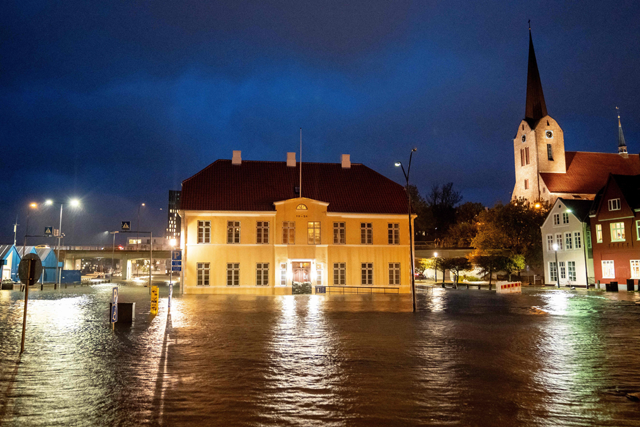You are here
13 dead as Storm Eunice hits power, transport in Europe
By AFP - Feb 20,2022 - Last updated at Feb 20,2022
LONDON — Emergency crews Saturday battled to restore power to more than one million homes and businesses after Storm Eunice carved a deadly trail across Europe and left transport networks in disarray.
At least 13 people were killed on Friday by falling trees, flying debris and high winds in Britain, Ireland, the Netherlands, Belgium, Germany and Poland, emergency services said.
Train operators in Britain urged people not to travel, with trees still blocking several lines after most of the network was shut down when Eunice brought the strongest wind gust ever recorded in England, 122 miles per hour.
In Brentwood, east of London, a 400-year-old tree crashed into a house and bedroom where 23-year-old Sven Good was working from home, as millions of other Britons heeded government advice to stay indoors.
Good said he heard a "creak and then a massive bang and the whole house just shuddered".
"I could feel the whole roof going above me. It was absolutely terrifying," he told Sky News, adding that none of the occupants was injured.
The train network in the Netherlands was also paralysed, with no Eurostar and Thalys international services running from Britain and France after damage to overhead power lines.
France was grappling too with rail disruption and about 37,000 households were without electricity, while some 8,000 remained cut off in Ireland and 4,500 in Germany, where rail operator Deutsche Bahn said "more than 1,000 kilometres of track had suffered damage”.
Poland still had one million customers cut off on Saturday afternoon, officials said, after the country's northwest took a battering.
"I appeal to you: Please stay at home!" Polish Prime Minister Mateusz Morawiecki said in a Facebook post.
"We are constantly monitoring the situation and the appropriate services are at work. The fire brigade has already intervened more than 12,000 times," he said.
In the UK, 226,000 homes and businesses remained without power after 1.2 million others were reconnected.
'Explosive storms'
Eunice sparked the first-ever "red" weather warning for London on Friday. It was one of the most powerful tempests in Europe since the "Great Storm" hit Britain and northern France in 1987.
Scientists said both storms packed a "sting jet", a rarely seen meteorological phenomenon borne out of an unusual confluence of pressure systems in the Atlantic that magnified the effects of Eunice.
The Met Office, Britain's meteorological service, on Saturday issued a less-severe "yellow" wind warning for much of the south coast of England and South Wales, which it said "could hamper recovery efforts from Storm Eunice".
The UK's total bill for damage could exceed £300 million, according to the Association of British Insurers, based on repairs from previous storms.
At the storm's height, planes struggled to land in ferocious winds, as documented by the YouTube channel Big Jet TV which attracted more than 200,000 people to its live feed from near a runway at London's Heathrow airport.
Hundreds of other flights were cancelled or delayed at Heathrow and Gatwick, and Schiphol in Amsterdam.
A section of the roof on London's O2 Arena was shredded, and the spire of a church in the historic city of Wells, southwest England, toppled over.
Ferries across the Channel, the world's busiest shipping lane, were suspended, before the English port of Dover reopened Friday afternoon.
Experts said the frequency and intensity of the storms could not be linked necessarily to climate change.
But Richard Allan, professor of climate science at the University of Reading, said a heating planet was leading to more intense rainfall and higher sea levels.
Therefore, he said, "flooding from coastal storm surges and prolonged deluges will worsen still further when these rare, explosive storms hit us in a warmer world".
Related Articles
STOCKHOLM — Deadly Storm Babet unleashed extensive flooding and damaged towns in Denmark and Norway into Saturday, while continuing to sweep
LONDON — Ireland, Britain and France faced travel chaos on Saturday and one person died as a winter storm battered northwest Europ
BRISTOL — Teen climate activist Greta Thunberg told tens of thousands of environmental protesters in Britain on Friday that "activism works"


















